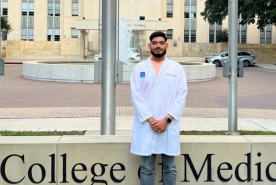Prostate cancer is now the most common cancer in American men. One of every 10 American men will develop prostate cancer at some time in his life. Prostate cancer is usually curable when caught and treated early. However, many cases are not diagnosed until the disease is advanced. Since early prostate cancer causes no symptoms, it can only be detected by regular checkups.
What is the prostate and what does it do?
The prostate is a small gland in men, about the size and shape of a walnut. It wraps around the urethra, the tube that carries urine from the bladder out through the tip of the penis. The gland's main function is to make fluid for semen, which transports sperm. During sex, the prostate's fluid is squeezed into the urethra where it combines with the sperm coming from the testicles. This fluid leaves the penis during ejaculation.
What is prostate cancer? What causes it?
Prostate cancer is a malignant tumor that usually starts in the outer part of the prostate. As the tumor grows, it may spread to the inner part of the prostate and then beyond the gland to other parts of the body. In the early stages, prostate cancer causes no symptoms. As the tumor grows, it may squeeze the urethra, causing urinary problems. The causes of prostate cancer are not known for sure, but some studies suggest that diets high in fat may contribute to the development of the disease.
My doctor says my prostate is enlarged. Does that mean cancer?
Not necessarily. You may have a condition called benign prostatic hyperplasia (BPH). This is a noncancerous enlargement that causes the gland to press on the urethra causing urinary problems. About 80 percent of men develop this condition as they age. BPH does not cause cancer, but some men may have both BPH and prostate cancer.
How do you know if you have prostate cancer?
There may not be any symptoms in the early stages. When the tumor enlarges and begins to press on the urethra, you may have some of the following:
- need to urinate more often, especially at night
- difficulty urinating
- pain or burning when urinating
- blood in the urine.
Since prostate cancer is "silent" in the early stages, the only way to detect it early is to have regular checkups. The American Urological Association (AUA) recommends that men should start having a yearly prostate examination at age 50. The examination is a simple office procedure called a digital rectal exam. This helps the doctor determine whether the prostate is enlarged, has lumps or areas that feel abnormal.
The AUA also recommends that men aged 50 or more have a yearly blood test called a prostate specific antigen (PSA) test. This measures the level in your blood of PSA, a substance that increases when prostate cancer is present. While some men with BPH or prostatis (an infection of the prostate) may also have increased levels of PSA without cancer, this test does help to increase the chances of detecting prostate cancer in the early stages.
Men who have an increased risk of developing prostate cancer, including African-American men and men who have a father or brother who has had prostate cancer, should start having these yearly examinations at age 40.
Are there other tests for prostate cancer?
Yes. If the doctor feels that a cancer may be present, additional tests may be ordered. This may include a biopsy of the prostate. A biopsy of the prostate involves removing a small sample of tissue, which is examined under a microscope to check for the presence of cancer cells. If the biopsy is positive, other tests may be done to see whether the cancer has spread. These may include computed tomography scanning (CT scanning) and magnetic resonance imaging (MRI).
How is prostate cancer treated?
The major treatments for localized prostate cancer are surgery and radiotherapy. The survival rate for men with localized prostate cancer that is treated promptly is about the same as that for men who have never had the disease. The surgery, which is called radical prostatectomy, involves complete removal of the prostate and adjacent structures. Regional lymph nodes are often removed at the time of the procedure. In some cases, radiotherapy can be used. This involves focusing a beam of radiation on the tumor or implanting radioactive seeds directly into the prostate.
Immediate treatment may not always be recommended because some prostate cancers grow very slowly and take a long time to spread. Therefore, some doctors may recommend "watchful waiting," especially for men who are very old or who have a life expectancy of less than 10 years.
In cases where the cancer has spread beyond the prostate, hormonal therapy or chemotherapy may be done. You should discuss the pros and cons of these treatments with your doctor.

















